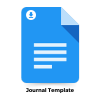Writing Guidlines
Before Submission
Please read the following information carefully before submitting an article. The publisher reserves the right to return manuscripts that are not prepared in accordance with these instructions.
Submission of manuscripts to this journal is done fully online and authors must log in or create a new account. After that, authors can use the personal dashboard to submit new manuscripts and track the status of the article.
Article Authenticity
Manuscripts are written in the format required by the Computer Science and Informatics (COMPSI) Author Guidelines:
The manuscript does not contain plagiarism, falsification and/or data fabrication.
The manuscript is not currently submitted to another publication and is not under review for publication elsewhere during the Computer Science and Informatics (COMPSI) review process. Manuscripts are not accepted for publication elsewhere.
Submitted files are in OpenOffice, Microsoft Word, RTF, or WordPerfect document file formats.
Format
Manuscripts should be written in standard English. The total number of pages is 8-12 pages (including figures and tables), and appendices should not be included in the manuscript. The manuscript is written single-spaced on one side of A4 size paper (210 x 297 mm), single-column format with page arrangement: top margin 2.5 cm; bottom 2.5 cm; left 2.25 cm and right 2.25 cm. The manuscript of the article is written in Times New Roman font size 12pt and paragraph indentation 1cm. The writing style refers to APA Style (The American Psychological Association).
The manuscript is presented in several sections: Introduction (Introduction contains the background of the problem, theory, research objectives written in the form of flowing paragraphs), Literature Review (Includes theoretical framework, hypothesis development), Research Methodology (methods, types of data, data sources, data collection techniques, population, samples, data analysis techniques), Results and Discussion, Conclusions and Suggestions, Bibliography.
Title
The title should be specific, effective and informative in accordance with the purpose of writing, no more than 12 words in English, so that it can be comprehensively understood. The font size for the article title is Times New Roman 14pt, with capital letters, bold and centred.
Author
The author's identity contains the author's name (without title), institution of origin, institution address for correspondence, and author's email. The author's name (without title) is in Times New Roman 12pt font, with capital letters at the beginning of each word, bold, and centred. Below the author's name is the origin of the institution, the author's email, with Times New Roman 11pt font, and capital letters at the beginning of each word, without bold.
Abstract
Abstract is written between 150-200 words, italicised in two languages, Indonesian and English. The English abstract is written first and then the Indonesian abstract. Abstract is not a summary consisting of several paragraphs. The contents of the abstract include research objectives, research data/objects, methods, results, findings or conclusions. The font size is 11pt.
Keywords:
Writing keywords or keywords, adjusting to the language in the article. Keywords are written in Indonesian and English. The keywords are carefully selected, accurate and able to reflect the concepts/variables contained in the article, with between three and five keywords. Written in alphabetical order, the keywords are separated by semicolons (;).
INTRODUCTION
The introduction contains the background of the problem, theory, research objectives written in the form of flowing paragraphs.
LITERATURE REVIEW
Literature Review contains grand theory and other theories presented in complete and concise sentences. In addition, it contains references that are relevant to the relevant previous research contained in the introduction. As well as explaining hypothesis development (if any) and without subchapters.
RESEARCH METHOD
The research method contains the research design used (methods, types of data, data sources, data collection techniques, population, samples, data analysis techniques, written in the form of flowing paragraphs without numbering.
RESULTS AND DISCUSSION
Contains research results written systematically, critically, and informative analyses. The use of tables, figures, and others is only as support to clarify the discussion and is limited to substantial support, such as tables of statistical test results, model test results, and others. The discussion of results is argumentative regarding the relevance of the results, theory, previous research and empirical facts found, and shows the novelty of the findings.
Each table is written without vertical lines and is accompanied by the source of the year of data processing. The output of a table is written manually in the draft article, showing only the data needed (not directly from the output). The title is written above the table left-aligned (11 bold letters).








